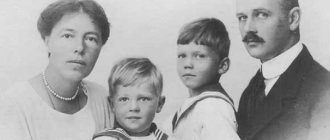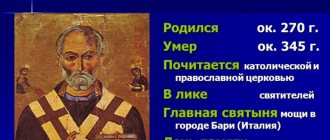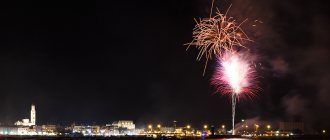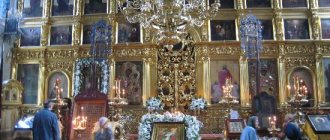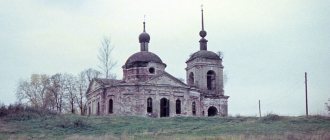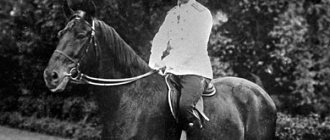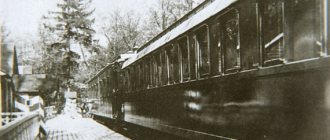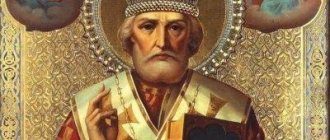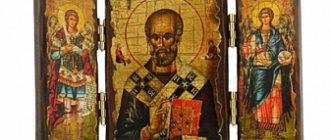About the miraculous image of the Sovereign Emperor Nicholas II
The miraculous myrrh-streaming image of the Tsar-Martyr Nicholas II has a keeper - Moscow surgeon Oleg Ivanovich Belchenko. He travels with her to churches and monasteries when his busy work schedule allows, at other times he is helped by people who care for the image. Small paper icons are printed with the money of private benefactors, and the proceeds from their distribution go to the production of large icons, which Oleg Ivanovich gives to churches with the hope that each church will soon have its own icon of the Sovereign.
Oleg Ivanovich, please tell us the story of the painting of the icon of the Tsar-Martyr Nicholas.
A sad paradox of the 20th century: the icon of the last Russian emperor, martyr Nicholas II, was painted on the other side of the ocean, in the United States of America, even before the glorification of the Tsar in Russia.
And there is an amazing story connected with this event. The year was 1997. The Russian emigrant Iya Dmitrievna Shmit, nee Podmoshenskaya, had a dream in which she saw an icon depicting the martyr Emperor Nicholas II in grand ducal attire. A few days before, the woman received a small inheritance and was going to contribute to a good cause. Upon awakening, the question of what to donate the money to was resolved for her. She asked the icon painter Pavel Nikolaevich Tikhomirov, who lives in California, to paint the icon she saw. Together they began to study photographs of Nicholas II in search of a plot and the same facial expression as in the dream. The king was supposed to wear Monomakh's hat, with a scepter and orb.
On the left of the icon is depicted the righteous Job the Long-Suffering, on the day of whose memory Nicholas II was born, on the right is the heavenly patron of the Sovereign, St. Nicholas the Wonderworker. And below is the inscription: “This holy icon was written for the glorification of the Martyr Tsar in Russia.” And this was several years before the canonization of the Royal Martyrs.
The icon itself is still kept at Iya Dmitrievna’s home. She began selling lithographs made from it to help Russian people who found themselves in difficult situations abroad.
How did the image appear in Russia?
Abbot Herman (Podmoshensky), Iya Dmitrievna’s brother, brought with him several images. One of the color lithographs of the icon ended up in the St. Nicholas almshouse in Ryazan. It was inserted into the icon case and hung behind the candle box. There I first saw this image. On that spring day, I helped my friend bring boxes of spiritual literature to the almshouse. The books were donated free of charge, and in gratitude my friend and I were each given the same lithograph. This happened on March 15, 1997 - exactly eighty years after the Tsar was forced to sign an act of abdication.
For a year and a half, the lithograph of the Tsar’s icon was kept in my home. But gradually I began to notice changes happening to her. First, a spot appeared under the Tsar’s right eye, as if it was blood, then the same spot appeared under his left eye. The colors gradually changed. I turned to the priest, and he suggested taking the image to the church. That's what I did. On September 6, 1998, I brought the image to the church of the Sretensky Monastery, of which I was a parishioner. I couldn’t put the plastic bag in which the icon was on the table, so I held it in my hands.
In those years, the Emperor had not yet been glorified, but then, completely unexpectedly for me, the priest asked the choir to sing a troparion to the Martyr Tsar... People in the church began to turn around and look in my direction. And I couldn’t understand what was happening. It turned out that with the singing of the troparion a fragrance spread throughout the temple. And because of the runny nose, I was the only one who didn’t feel it.
After the service, I took out the lithograph, and the fragrance only intensified. The parishioners divided the package into pieces among themselves - and now, years later, these scraps continue to emit a smell. Everyone was shocked, and the priest said: “Let us hold this icon in our altar, and then we’ll see what to do.”
I was delighted.
Of course, the icon of the Emperor should be in the altar. But, I repeat, at that time the Royal Martyrs had not yet been glorified as saints. Three weeks later I asked the priest: “Does she still smell fragrant?” “Yes, it smells fragrant,” he replied. “And what will happen next? Maybe I should put it on the lectern or should I still take it?” The priest consulted with someone and said: “Take it.” And the image began to move from temple to temple, traveling throughout Russia?
Yes. At that time, Hieroschemamonk Rafail (Berestov) arrived in Moscow. I approached him with a request: “Father, determine the fate of this icon. If you tell me to take it to some temple, I’ll take it, tell me to keep it at home, I’ll keep it at home.”
Father Raphael looked at the lithograph for a long time, and then answered: “This is a kind of myrrh-streaming. The droplet does not have time to form and evaporates, but the smell remains. Don’t worry, it will still flow visibly.” Then he remarked: “Don’t rush to assign her to some temple. The Emperor has not yet been canonized. But the Lord will tell you what to do with it. And if you want to hear my advice, then carry it around the temples and where they agree to place it on a lectern, leave it for a while.” This advice was later repeated almost word for word by Archpriest Nikolai Guryanov and Archimandrite Kirill (Pavlov): where the believers will worship, leave the image.
Thus, with the blessing of Hieroschemamonk Raphael, the miraculous lithograph of the icon began its journey through churches and monasteries. More than 20 dioceses accepted the image of the Martyr Tsar before his glorification at the Council of Bishops in 2000.
The icon began to move from temple to temple. At first they brought her to the Novodevichy Convent, where Mother Seraphima (Chichagova) was then abbess. When I took the image, I forgot the diplomat in the monastery. Approaching the metro, one of my companions said: “Something unusual is happening. A trail of fragrance trails behind you.” The frost was severe. We stopped, took the lithograph out of the bag and saw that its case was completely saturated with the world. Then a nun caught up with us, and her first words were: “I followed the smell, the fragrance is from the monastery.” Then she gave me the diplomat.
When did visible myrrh-streaming begin?
For some time, the image was kept by a parishioner, a friend of mine. On November 7, 1998, I went to see her and saw a drop of amber-colored myrrh flowing down the icon... The words of Father Raphael came true that the myrrh would flow out visibly. For some unknown reason, it flowed not immediately from top to bottom, but first horizontally, against all the laws of gravity.
A monk I knew from the Solovetsky Metochion arrived and, having collected a few drops, said: “Today there will be an all-night vigil, I will mix this ointment with oil and anoint it with it.”
A week later, the image was received in the Church of the Ascension of the Lord on the Pea Field. Almost every day the lithograph streamed myrrh, akathists were read before it, and this continued for several months. On February 28, 1999 - it was the day of the Triumph of Orthodoxy - the image was transferred to the Church of St. Nicholas the Wonderworker in Pyzhi. Archpriest Alexander Shargunov agreed to receive him with great joy. They took on the image with the ringing of bells and laid out a carpet up to the gate. On this day it flowed especially strongly. The whole parish was united in its prayer, the soul sang with joy. When the image of the Tsar-Martyr Nicholas was brought to this temple for the second time, the line of people wishing to venerate it began at the Tretyakovskaya metro station. Muscovites know that this is not a small distance.
Do you know any cases of healing from the myrrh-streaming icon of the Tsar-Martyr Nicholas?
Yes, and there are quite a lot of them. I personally know one person who received healing through his prayer. Orthodox radio stations began to talk about the image. Then retired colonel, former head of the department of one of the military universities in Moscow, Alexander Mikhailovich Vytyagov, heard about him. During the Great Patriotic War, he received many wounds, eventually became blind, and for the last fifteen years he has not seen anything.
At Vytyagov’s request, his relatives took him to churches following the icon of Tsar Nicholas. And when the image was received at the Church of the Life-Giving Trinity in Khokhly, he asked to be taken to the rector, Archpriest Alexy Uminsky, and turned to the priest with the words: “Father, I believe this icon will heal me.” Father Alexy simply, without hesitation, answered: “According to your faith, it will be given.” He led Vytyagov to the icon and covered his head with a towel soaked in the world. The military man later recalled: “I don’t remember what prayer I was reading at the time.” But only the next morning he woke up, looked around the room and shouted: “I see!”, so loudly that everyone at home came running to him.
This was the first healing from this image, accomplished through prayer to the Emperor. Vytyagov subsequently told me at a meeting: “I believe that soon I will take off my glasses.”
Many healing miracles also happened in Ukraine. One day a woman with a huge belly was brought to the image of the Martyr Tsar. This disease is called ascites: fluid accumulates in the abdominal cavity. She was breathing heavily, choking. After kissing the icon, her stomach sank. It was not clear even to the doctors where the liquid went. The woman stopped being tormented by pain, and she died very quietly and calmly, thanking God for the relief of her suffering given before her death.
Another story. The man had a high fever and his arm was lost. For this reason, he was at home on sick leave for a long time. But when I venerated the miraculous image, I felt healthy, and the very next day I went to work.
Please tell us about the travels of the miraculous image.
Surprisingly, most often we were invited to places where the Emperor wanted to go in his earthly life, but never had time. And all the journeys took place with God’s help. During this time, the miraculous image flew by plane throughout Russia, Ukraine and Belarus, visited Greece, France, Germany, Belgium, Holland, Serbia, Macedonia and even Mount Athos.
In 2002, the image of the Sovereign visited Yekaterinburg. Even in the then unfinished Church on the Blood, the All-Night Vigil was held. When we were returning from the Liturgy in Yekaterinburg, we stopped in Alapaevsk, and then in Verkhoturye. In this city, near the monastery, there is one very beautiful building. It turned out that this house was specially built for the Emperor, and only the First World War prevented him from arriving in Verkhoturye and venerating the holy relics of Simeon of Verkhoturye...
Having learned about the myrrh-streaming of the miraculous image of Tsar Nicholas, they began to invite me to many countries. Finland was the first. But then I didn’t go for fear of losing an icon for Russia forever. Copies were made without the permission of the icon painter, therefore, in violation of copyright law. It was very sad. Then came an invitation to France. And then I called Iya Dmitrievna Shmit. A conversation took place between us. I said over the phone: “I’m afraid to go abroad, because copies of the icon were made without your permission. This means that according to the law, the image can be taken away. And I’m scared even by the thought that Orthodox Christians in Russia will never see her again.”
On the other side of the world, Iya Dmitrievna said into the phone: “Don’t be afraid of anything. When I learned about the miraculous lithograph from my icon, I initially experienced a feeling of jealousy. And then I realized that a great miracle had happened. Be sure to call me when you arrive in France. I want to venerate the miraculous image.” We met in France, in Paris in the church of the Russian Orthodox Church Abroad in honor of All Saints who shone forth in Russia.
In Germany, the lithograph was in Darmstadt together with Father Alexander Shargunov, rector of the Church of St. Nicholas the Wonderworker in Pyzhi. The city of Darmstadt is the birthplace of the wife of Emperor Alexander II Maria Alexandrovna (nee Princess Maximiliana Wilhelmina Maria of Hesse), as well as the holy sisters of Empress Alexandra Feodorovna and Grand Duchess Elizabeth Feodorovna (nee princesses of Hesse-Darmstadt). There is an amazingly beautiful Orthodox church in honor of St. Mary Magdalene. It stands on Russian soil. Tsar Nicholas II ordered to bring land from Russia and build a Russian temple only on it.
It is providential that the Emperor, in his miraculous way, began his visit to Belarus from the city of Mogilev. It was here that he said goodbye to the army. It was here that the Golgotha of the last Russian Emperor began, ending tragically in Yekaterinburg.
We were invited to Mogilev by Archbishop Maxim of Mogilev and Mstislav. The bishop himself could not accept the miraculous image, since he had just undergone surgery and was in the surgical department in Minsk. But the group that brought the lithograph visited him in the hospital. A prayer service was served in the ward. Saying goodbye to the icon of the Emperor, the Bishop venerated the miraculous image. And he poured myrrh in the hands of the archpastor.
In the Spaso-Preobrazhensky Valaam Monastery they also waited with trepidation for the myrrh-streaming image. The boat slowly moored to the monastery pier. Already on the approach to the Nikolsky monastery, my companions and I heard the solemn ringing of the bells of the Valaam Monastery. The entire shore was filled with pilgrims, residents of the island of Valaam, and inhabitants led by the abbot of Northern Athos, Archimandrite Pankratiy, who met the miraculous image of the Sovereign Emperor. During the religious procession, the icon of Tsar Nicholas was transferred to the Transfiguration Cathedral. The entire temple sang a prayer to the Holy Spirit. The image smelled wonderfully - waves of fragrance literally filled the cathedral. For a long time, those gathered in the temple venerated the icon.
With the blessing of Father Pankratiy, the myrrh-streaming image visited almost all the monasteries. Prayer services and akathists with a large crowd of worshipers were performed wherever the icon was transferred. The stay of the miraculous image in the monasteries was accompanied by the streaming of myrrh either from the very image of the Martyr Tsar, or from temple icons streaming myrrh. The stay on Northern Athos ended with a religious procession on a boat on the water around the Valaam archipelago. This is how Sovereign Emperor Nicholas II visited this blessed monastery for the first time - with his miraculous, myrrh-streaming image, from which many have already received healing and many thousands have received immediate help and consolation.
You said that the image even visited Mount Athos.
Emperor Nicholas II really wanted to visit Athos. However, he was unable to make his dream come true due to a number of circumstances. But his image visited the Holy Mountain twice. The priest who carried the icon, despite the fact that it was difficult to climb the mountain, did not want anyone else to take his place. He treated the path as personal obedience. Of the twenty Athos monasteries, we visited seventeen in two trips. When we arrived at the Russian St. Panteleimon Monastery, the image was first placed in the cell. Upon entering, one of the monks recognized the face of the Emperor - and he was immediately carried into the temple with honor.
A similar story happened in the Serbian monastery of Hilandar. We went to the service, and left the icon in the cell. She began to cast myrrh again. And the governor of the monastery asked to transfer the image to the temple. Monks came from all obediences and watched the image of the Royal Martyr stream myrrh.
We even went to the very top of Mount Athos. Russian pilgrims organized a service, the image streamed myrrh...
Please tell us about the “flight of the cross” over Russia.
In June 1999, the image of Tsar Nicholas, along with other miraculous icons, flew around the borders of the former Russian Empire with the blessing of Patriarch Alexy II. The plane flew over Minsk, Kiev, Crimea, Chechnya, Novosibirsk and Kamchatka. For the first time, a religious procession along the borders of Russia was carried out not by land or water, but by air. But its incarnation was preceded by an amazing story. In 1997, Sergei Aleksandrovich Matveev received a blessing from Elder Nikolai Guryanov to carry out a religious procession along the borders of Russia on an airplane. This event, important for the Orthodox world, was prepared for two whole years. The flight route was carefully coordinated with the Ministry of Defense and other organizations. The most difficult thing the organizer of the religious procession faced was finding the funds necessary for the flight. Desperate, Sergei Alexandrovich was about to go again to Father Nikolai on Zalit Island so that he would remove the impossible blessing from him. But the situation developed providentially. On May 19, 1997, on the birthday of the Sovereign Emperor Nicholas II, Sergei Alexandrovich attended the religious procession and witnessed the myrrh streaming of our icon of the Sovereign. Impressed by his soul, he included the myrrh-streaming image in the lists of shrines participating in the flyby.
Only after this the necessary funds suddenly appeared to implement the idea. Two days later, a Russian entrepreneur donated the required amount.
Throughout the air journey over the borders, miracles constantly occurred. The religious procession in the sky, although it was blessed by His Holiness the Patriarch and Elder Nikolai Guryanov, was carried out without wide publicity. And few people knew about the flight. Any airport is a closed institution; outsiders are not allowed there. And the first to see the miraculous image of Tsar Nicholas were airport workers. Not knowing anything about it, they entered - and immediately a fragrance and myrrh began to flow. When they left, everything stopped. This happened every time. The plane flew over Saratov, Volgograd, Omsk, Novosibirsk.
When we stopped in Anadyr, there was a continuous stream of people coming to the image from 9 pm until 2 am. It still remains a mystery: how they learned about the appearance of icons in their city.
Many miracles took place along the heavenly path of shrines along the borders of Russia. One of them was even filmed and shown on television. During the flight, some of the icons were displayed through the windows. And only above the image of the Sovereign an ice crown formed. All other glasses were transparent. The icon of the Russian Sovereign was placed in a hemispherical porthole; this was the most convenient place for it. At some point, the porthole froze, and a bizarre pattern of ice crystals formed on the glass, reminiscent of a star with symmetrical angles diverging from the image in different directions. The decoration, like an extraordinary crown, consisted of 12 rays, three on each side. Subsequently, the pilot said that in the five years of his flying career he had never seen anything like this.
Oleg Ivanovich, who is the Sovereign Martyr Nicholas for you?
I am convinced that now the Emperor is one of the greatest intercessors before the Lord for the Russian Land. Being the custodian of his miraculous image, I read a lot of books about the life of the Royal Family. And the more I read, the more I was amazed at the genuine delicacy, nobility and spirituality of Nicholas II.
There is one historical memory. The Emperor read all the mail himself. And so one poor widow, who had lost her husband and breadwinner in the war, wrote him a letter in which she told him that she had children left and her pension was very small. Then the Emperor asked the Minister of Finance: “Can we raise the unfortunate woman’s pension?” He replied that no. Then the Emperor said: “Take it from me.” By the way, only a few rubles remained after his death in his London bank account...
Tsar Nicholas had a broad soul. And after his martyrdom, having shone among the saints, he continues to help people who turn to him with faith and prayer.
Myrrh-streaming icon of Tsar-Martyr Nicholas II on Valaam
Myrrh flow and fragrance from holy icons and relics. On July 21, 2000, on the day of the celebration of the Kazan Icon of the Mother of God, the icon of the Tsar-Martyr Nicholas II Alexandrovich arrived to the holy land of Valaam from St. Petersburg.
During the stay of this icon in Odessa on February 15, 2000 (The Presentation of the Lord), Metropolitan Agathangel of Odessa and Izmail announced the canonization of St. Royal Martyrs. At the time of the canonization of St. The Holy Fire descended upon the throne of the Iveron Monastery to rank the royal martyrs.
The icon of the Tsar-Martyr was painted by the Russian artist Pavel Tikhomirov in the USA. In 1998, lithographs of the icon were brought to Moscow. One of the lithographs ended up in Ryazan, where several color photocopies were made in the St. Nicholas almshouse. The photocopy, framed and in an ark, was presented to R. B. Oleg March 15, 1998. On the icon is the image of the Tsar-Martyr Nicholas II in grand ducal attire with the Scepter and Orb in his hands. In the upper corners of the icon there are two marks: Job the Long-Suffering, whose feast day is the day of remembrance of Nicholas II, and St. Nicholas the Wonderworker, the heavenly patron of the Emperor. Under the image in the oval are the words: “This holy icon was painted for the glorification of the Tsar in Russia.”
On September 6, 1998, the icon began to smell fragrant in the Sretensky Monastery in Moscow. With the blessing of the confessor of the Trinity-Sergius Lavra, Archimandrite Kirill (Pavlov), Archpriest Nikolai (Guryanov) from the island of Zalit and the Valaam elder Hieroschemamonk Raphael (Berestov), the icon is transferred from church to church for veneration by believers.
The fragrant icon of the pious Tsar-Martyr visited various churches and monasteries in over two dozen dioceses.
The icon exudes fragrant myrrh from time to time. Nine healings from various diseases have been recorded over the past two years. During the icon’s stay in the Tulchino-Bratslov diocese in June of this year, 4 healings occurred. The cases of healing documented in the report were transferred to the clergy.
On July 1, the icon of the Tsar arrived in White Rus'. She was solemnly welcomed in churches and monasteries in the cities of Mogilev, Bobruisk, Minsk and the Minsk region. They prayed before the holy icon of the Martyr Tsar in the Zhirovitsky monastery and in the monastery of Euphrosyne of Polotsk.
On July 15, the icon of the pious Tsar was solemnly received by the Valaam courtyard in the city of St. Petersburg. On July 17, the day of the murder of the Royal Martyrs, thousands of believers walked with the miraculous icon in the procession dedicated to this mournful date in the history of the Fatherland. The prayerful standing at the walls of the Kazan Cathedral ended with a prayer service and the singing of an akathist to the Tsar-Martyr. With great enthusiasm, thousands of believers sang the hymn-prayer of the Russian people: “God Save the Tsar...”
St. Petersburg saw tears of sorrow and tears of forgiveness, tears of joy from meeting the miraculous image of Emperor Nicholas II, tears of repentance. Despite the rain, for more than three hours the people of St. Petersburg kissed the dear bright face of their Tsar.
On July 19 at 10:30 p.m., the flow of fragrant myrrh over the icon was recorded. The brethren of the Valaam metochion and soon joined by 180 pilgrims from Ukraine, led by Archbishop Niphon of Lutsk and Volyn, reverently prayed before the myrrh-streaming image of Nicholas II. The collected oil was consecrated with the oil with which Bishop Niphon anointed everyone in the temple.
On July 21, the miraculous icon of the Martyr Tsar was solemnly greeted by Northern Athos. Already as the ship approached the St. Nicholas Skete, the bells of the majestic Transfiguration Cathedral began to ring.
The brethren of the Valaam Monastery, led by the abbot Archimandrite Pankratiy, pilgrims and residents of the island reverently accepted the miraculous holy icon.
With a procession of the cross from the monastery bay, the image of the Tsar-Martyr was carried and placed on a lectern in the church of the monastery of the holy Venerable Sergius and Herman. Numerous pilgrims, residents and brothers who filled the temple fervently prayed at the miraculous icon.
“Original, Orthodox Rus', God save the Tsar!...” echoed under the arches of the monastery in the voices of hundreds of believers at the end of the prayer service. Throughout the night the temple was open for worship of the shrine. The shrines of the Venerables Sergius and Herman again sounded: “Rejoice, Nicholas, God-crowned Tsar and great passion-bearer...”
Already during the thanksgiving service, a strong fragrance and the release of drops of myrrh on the glass of the icon case were noted. At night, when pilgrims read the akathist at the icon. Myrrh was already flowing across the glass. Before the start of the Divine Liturgy, despite the fact that the icon was often wiped with a clean cloth due to the many people who wanted to venerate the shrine, divine fragrant moisture appeared on the glass almost constantly. Before the Sunday all-night vigil, it became known that icons were streaming myrrh in the iconostasis of the church in the name of St. Fathers who shone in fasting, at the Igumenskoe cemetery. Myrrh-streaming of icons in the Valaam Monastery
The hegumen of the monastery, Archimandrite Pankraty, and Oleg Ivanovich Belchenko, the keeper of the miraculous icon of the Tsar-Martyr, immediately went there, who testified to the presence of myrrh flowing in streams over the entire surface of the icon of the Savior (a printed copy pasted on the board) and two streams of myrrh on the surface of the icon of the Mother of God.
The next day, Sunday evening, three streams of peace appeared from the blessing right hand of the Savior on the large 17th century icon on the right pillar of the Cathedral. The transparent and thick myrrh collected on cotton wool exuded a strong, unearthly aroma, which was witnessed by the brethren and numerous pilgrims who were anointed with the myrrh mixed with oil.
On the fourth day of the myrrh-streaming icon’s stay on Valaam, after it was brought back to the Cathedral after visiting the All Saints Skete, where the newly glorified venerable elder Antipas of Valaam labored, a wonderful and very strong fragrance began to emanate from his holy relics. The relics of the monk had emitted a fragrance before, for example, during the 1st week of Great Lent in 1996, but the brethren had never felt such a strong aroma.
The icon of the Tsar smelled strongly and exuded myrrh during the prayer singing at the Smolensk monastery; after the end of the prayer service, myrrh began to stand out on the icon of the Smolensk Mother of God. The miraculous icon visited all the monasteries, a religious procession along the waters with the icon of the Martyr Tsar was made around the islands of the Valaam archipelago, On Friday, the brethren saw off the myrrh-streaming image, which will arrive in Moscow on Sunday.
Valaam July 2000
Icon of Nicholas II
The Holy Martyr Nicholas II is an example of a righteous life for every Orthodox person. Prayers in front of the image of the Russian Tsar can help you completely change your life and destiny for the better.
History of the icon
It is well known that the tortured Nicholas II and his family were canonized not so long ago. Meanwhile, it was the future canonization that played the main role in the appearance of a separate icon of Nicholas II.
A Russian emigrant living permanently in the United States dreamed of the image of the last Russian Tsar in a special robe. The woman had just received a small inheritance, which she intended to spend entirely on charity. The next morning, the question of where to send the funds was removed once and for all. The woman asked a Russian artist living in Chicago to take on the image of Emperor Nicholas from her dream.
When the icon was ready, it was placed at the customer’s home. It is noteworthy that a few years after the creation of the image, the royal family was canonized.
Where is the holy image located?
The original image of Nicholas II remains to this day in the house of a pious woman. Lists and copies of the image are gradually being distributed to all Orthodox churches both in Russia and abroad.
Description of the icon
The icon depicts the last Russian Tsar Nicholas II in rich vestments and the cap of Monomakh. The saint holds a scepter in one hand and an orb in the other.
This image reminds every believer of the sacrifices the king made to defend his faith, people and beliefs. His death is a huge loss for the country, and the protection and patronage of the last king gives hope for a better future for every Orthodox person.
How does the image of St. Nicholas II help?
The death of the last Russian Tsar became a turning point in the history of our country. It is known that Nicholas II’s plans included abdication of the throne and movement towards democracy. It is justice that the image of the holy icon embodies.
People address the icon of St. Nicholas II:
- with prayers and requests for the restoration of truth;
- about fair retribution or warning;
- asking to protect the family from collapse.
Prayers before the image of the saint
“Oh, great king, overthrown and innocently killed during his lifetime, who has found peace in the Kingdom of Heaven! I humbly run and fall at your feet with tears: I pray, Lord, protect me and my family from slander, lies and injustice every day of my earthly life. May I not disgrace the teachings of our Lord Jesus Christ and humbly enter the gates of Paradise when my hour on earth strikes. Amen".
This prayer must be read if you have been unfairly offended, or if your family is in danger due to the slander of ill-wishers.
“Oh, Holy Great Martyr Nicholas, we pray to you: hear us, sinful and unworthy servants of the Lord, hear and do not leave our prayers unanswered. Saint Nicholas, cover with your cover the immortal souls and our bellies from all evil, injustice and torment of body and soul, so that by word, deed or thought we do not disgrace the gift given by the Lord. Amen".
This prayer can help you protect yourself from wrong decisions and save yourself from lies and dishonor.
Prayers for the forgiveness of sins in front of the icon of Nicholas II have special power: with their help, you can completely cleanse your soul of burdens and change your life, directing it along the right path.
For the birthday of the Passion-Bearer Tsar
As RNL learned, with the blessing of the vicar, Bishop Nazarius of Kronstadt, a large cross-walking icon of the passion-bearing Tsar Nicholas II, painted in Serbia, was brought to the Holy Trinity Cathedral of the Alexander Nevsky Lavra in St. Petersburg. The shrine will remain in the monastery until June 15.
Serbian brothers in Christ told us the story of the icon. In 2018, in Serbia, with the blessing of the rector of the Church of the Archangel Michael in Korenica, Father Nikolai Malobabich, and the rector of the Church of the Prophet Jeremiah near the city of Smederevo, Father Dusan Popovic, three large cross-walking icons of the kings were painted. The icon painter of these images wished to remain anonymous. The icon of the Tsar-Passion-Bearer Nicholas II was consecrated in the ancient church of the holy prophet Jeremiah in the town of Verbovets near the city of Smederevo on February 24, 2021. Serbs revere this place - after all, during the First World War in 1916, about three thousand Serbian soldiers died here.
When the priest Dushan, co-served by four priests, consecrated the icon, it became myrrh-streamed. There were a lot of believers in the temple, they all knelt down in prayer. This was the first miracle from this icon.
Over the course of two years, the icon took place in many religious processions, blessed by His Holiness Patriarch Irenaeus, in Serbia, Montenegro, Republika Srpska, Kosovo and Metohija. Many people prayed before the icon of the Tsar-Martyr Nicholas and bowed to his holy image. In the monasteries and churches where the icon was located, people often stood in long lines just to bow to the beloved Russian Tsar in Serbia and venerate his venerable icon. There are known cases of miraculous help through prayers to the passion-bearer Nicholas in front of the newly painted image.
Thus, schema-nun D. from the monastery of Vasily Ostrozhsky on Mount Rozhai was seriously ill with leukemia. Five years before the arrival of the Tsar's Icon at the monastery, she accepted the schema. The image of the Tsar was in the monastery church for three weeks. Every day after the liturgy, the nuns read an akathist to the holy King. Then the icon was taken away to visit the holy places of Central Serbia. Two weeks after this, the nun, feeling better, visited the doctor. Her tests turned out to be as if she had never been sick! The doctor was amazed. And now, thank God, she is healthy.
Almost thirty churches and monasteries in Serbia received the icon of the Sovereign, and with it two more royal icons - the holy King Lazarus of Serbia and King John the Strong (this is the name of the Sovereign Ivan the Terrible in Serbia). All of them became famous for their miraculous intercession and help.
The icons remained for three months in the Monastery of the Annunciation of the Blessed Virgin Mary on Mount Rudnik, where a lot of people came for them, as well as priests and monks from Central Serbia. Here and in other places between services, the Akathist to the Holy Tsar Nicholas or the Royal Martyrs was constantly read.
There were icons of the Kings in Belgrade, in the churches of St. Paraskeva Friday and St. Nicholas. Repeatedly participated in the Serbian-Russian religious processions, undertaken for the sake of strengthening the faith and salvation of the Serbian and Russian peoples. Many times, where the icons were located, a fragrance was felt.
The blessing to bring the icons to Russia was given by the spiritual fathers revered in Serbia - elders John (Ielenko) and Seraphim (Milkovich; † 12/24/2020). This mission was carried out by Mrs. Biljana Rakovich, the spiritual daughter of Father Seraphim, who passionately loved Russia and the Russian people.
The grace of God, which rests on the icons, also manifested itself at the Belgrade airport. While his employee, who at first coldly declared himself an unbeliever, ordered the movement of the icons to the gangway - and they were very large in cases, which created problems - he completely changed, literally transformed. At the end, having carefully placed the icons on a moving tape with other employees, he stood tall and gave military honor to the Russian Tsars! Those who helped him did the same. His eyes were shining. And the airport employees, seeing off the Tsars, cried, one knelt down.
The icons arrived in Russia at the beginning of Holy Week this year. The image of King Lazarus is now in the Rostov region. People also receive help from above through it.
For a week, with the blessing of the rector, Archpriest Konstantin Korolev and the honorary rector, Schema-Archimandrite Barsanuphius (Kuzmin), the icon of the Passion-Bearer Tsar Nicholas spent a week in the Church of All Saints who shone forth in the land of St. Petersburg, Kingisepp. Then, with the blessing of Archimandrite Nektary (Golovkin), the image was in the Church of Saints Peter and Fevronia in Peterhof for more than a week. Here the icon, brought into the temple, began to smell fragrant.
And the other day, the Serbian image of Tsar Nicholas arrived at the main monastery of St. Petersburg - the Alexander Nevsky Lavra, where it will stay until June 15. This does not seem to be a coincidence, because it happened on the eve of the 800th anniversary of the birth of the Holy Blessed Prince Alexander Nevsky. And also just a few days before the birthday of the most holy Sovereign Nikolai Alexandrovich and on the eve of the 300th anniversary of the proclamation of the Russian State by the Empire, which took place on the day of the Kazan Icon of the Mother of God. It is written about this event in historical documents: “On October 22 (Old Style), 1721, a mass was held in the Trinity Cathedral of St. Petersburg, and then the text of the peace treaty concluded with the Swedes was read out. Feofan Prokopovich delivered a sermon, describing all the famous deeds of the tsar, for which he deserves to be called the Father of the Fatherland, Emperor and Great. Following this, senators approached the tsar; Chancellor Count G.I. Golovkin turned to Peter with a request to accept the title of Father of the Fatherland, Peter the Great, Emperor of All Russia. Under the volleys of hundreds of guns from the Admiralty, the Peter and Paul Fortress and 125 galleys brought into the Neva, Peter accepted a new title... So Russia became an empire.”
The adoption of the imperial title marked important changes in Russia's international position, securing its position as one of the world leaders. Three years later, the All-Russian Emperor Peter the Great founded the Alexander Nevsky Lavra.
At the icon of King Lazarus
